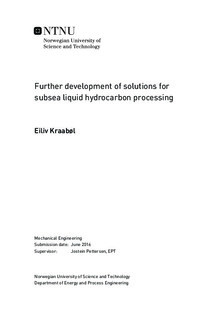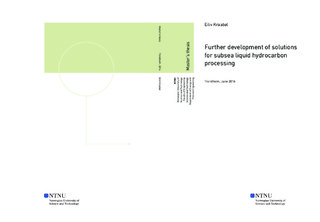| dc.description.abstract | Subsea processing has grown into a common vision for the industry known as All subsea . Process solutions presented take a big step towards this vision, and will be a significant extension from today s solutions. The systems developed are able to process hydrocarbons from the wells into products with acceptable specification for transportation and further processing in a downstream system. The processes solutions includes liquid stabilisation, gas cricondenbar/cricondenterm control, and gas dehydration. In addition there is a brief evaluation of subsea heat and power production.
Earlier research shows that partial stabilisation provides a significant simplification of the system, and a reduction in power consumption. This is confirmed by analysis presented in of this master thesis. The majority of process solutions presented in this study are therefore based on partial stabilisation.
Further development of process solutions is done based on conventional topside processing and the two-stage subsea solution developed by Kraabøl (2015). The configuration of the recompression system for flash gas from the stabilisation process, is found to have significant impact on system complexity, and has been in centre of design.
An assessment of equipment is presented, where ejectors and screw compressors where found suitable for flash gas recompression. Centrifugal compressors and pumps are found suitable for export of products.
Use of absorption, adsorption, selective membrane, and expansion/cooling is evaluated for gas dehydration. The recommended solution is to use a glycol absorption system. The system has two co-current contactors with downstream separators. This system is robust and provides the lowest glycol circulation rate of the systems analysed. Lean glycol is imported from a host, and exported back as rich glycol for regeneration, to reduce complexity and power consumption subsea.
In the end a system using dual screw compressors, with high operational flexibility is recommended. This system is able to operate with both lean and rich feeds, and can be also be used on an unmanned topside installation.
For lean feeds, having a relatively low flash gas rate, a very simple, robust, and compact system, including a high pressure separator and dual ejectors can be used. The drawback is that this system cannot operate with rich well streams. | |

